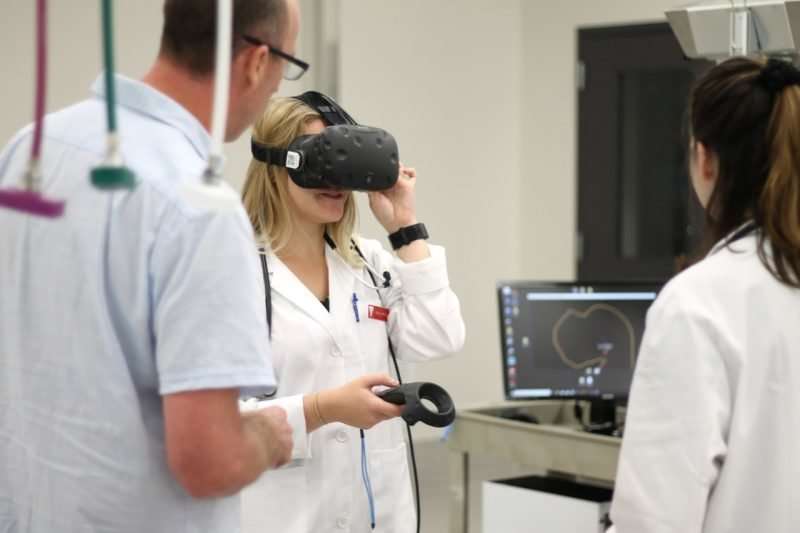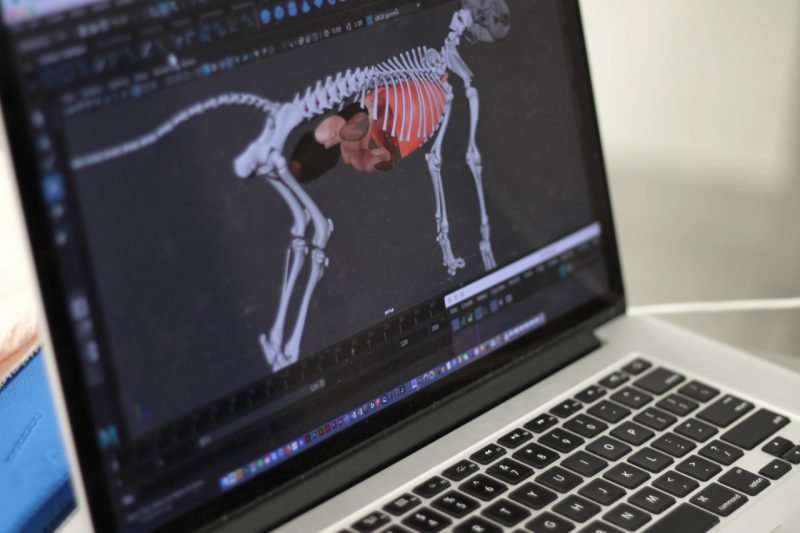Veterinary students try out a new virtual reality experience, created at Virginia Tech, that allows them to see and study a dog's anatomy. Credit: Virginia Tech
Sara Farthing, a first-year student in the Virginia-Maryland College of Veterinary Medicine at Virginia Tech, needed a mental picture.
As she practiced clinical exams on dogs during a lab, Farthing could not picture the canine's lungs and the way the heart is positioned inside the chest.
So she walked across the room and slipped on a virtual reality (VR) headset. Suddenly, she could see a large picture of a dog's lungs and skeletal structure floating in mid-air in front of her.
"I literally stood inside the rib cage," Farthing said.
The aspiring small animal veterinarian was using a new technology available this semester at the college that brings a dog's anatomy to life.
The VR experience, created by Thomas Tucker, an associate professor in the School of Visual Arts at Virginia Tech, shows up close the organs inside the skeletal system of a mid-sized dog. By moving and clicking a button, users can see layers of tissue, zoom in on certain organs, and step into parts of a virtual dog's body.
There is no other way to study a dog's organs and bone structure as intensively, said Michael Nappier, an assistant professor of community practice in the veterinary college's Department of Small Animal Clinical Sciences. Nappier teaches clinical skills education and a physical exam lab for first-year students.
This is one view of the virtual image of a dog that users see when they put on the VR headset. Credit: Virginia Tech
When the college switched curriculum models three years ago, Nappier noticed that students were struggling to connect their anatomy classes with what they were learning when they physically examined dogs. The anatomy was taught concurrently with the physical examination, instead of beforehand.
"I needed a different teaching method," Nappier said. "They [students] don't have the mental picture. I wanted to develop a way for this to be in the lab and to work with the dogs, so that the mental picture is inside of your head."
Other ways that students may study a dog's body parts involve examining drawings and cadavers. But in most of these cases, dogs are not standing on four legs as they would be during a typical veterinary examination. The new VR experience shows an image of a dog standing.
Nappier heard about Tucker's past work with VR and puppy motion capture, a visualization tool to study a puppy's social behavior. He contacted Tucker about his idea, and Tucker ran with it.
Since then, Tucker and five graduate and undergraduate students, most all creative technologies majors, have been crafting this 3-D VR image of a dog by using CT scans to place the organs correctly. They also worked with Bonnie Smith, an associate professor of anatomy in the college's Department of Biomedical Sciences and Pathobiology, to name the bones in a dog's body and to position them correctly.
Provided by Virginia Tech
























